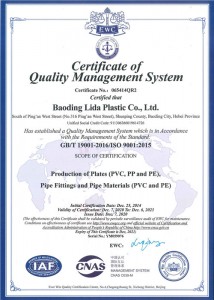paź . 20, 2024 04:53 Back to list
hdpe pipe jointing
Understanding HDPE Pipe Jointing Techniques and Benefits
High-Density Polyethylene (HDPE) pipes have become increasingly popular in various industries due to their superior properties, including flexibility, durability, and chemical resistance. One of the most critical aspects of HDPE pipe systems is the method of jointing. Proper jointing techniques ensure the integrity of the pipeline, prevent leaks, and extend the service life of the infrastructure. This article explores the various methods of HDPE pipe jointing, their benefits, and considerations for successful implementation.
Methods of HDPE Pipe Jointing
1. Heat Fusion Jointing Heat fusion is one of the most common methods used for joining HDPE pipes. This technique involves heating the ends of the pipes and then pressing them together until they fuse. There are several subcategories of heat fusion jointing, including
- Butt Fusion This method involves aligning the ends of two pipes and applying heat using a specialized machine until the surfaces melt and fuse together. It is particularly effective for pipes of similar or different diameters and can create a strong, monolithic joint. - Electrofusion In this process, a fitting with built-in electric heating coils is used. The fitting is connected to the ends of the HDPE pipes and an electric current is applied, causing the coils to heat the pipes until they melt and fuse. Electrofusion is ideal for joining pipes in more confined spaces or where precise alignment is critical.
2. Mechanical Jointing Mechanical jointing methods involve using fittings, bolts, or clamps to connect sections of HDPE pipes. This method can be advantageous in situations where heat fusion cannot be practically applied. Mechanical joints allow for easy disassembly and maintenance, making them valuable for temporary installations or situations where future modifications may be required.
3. Socket Fusion Socket fusion is similar to butt fusion, but it is used primarily for smaller pipe sizes. In this technique, a pipe end is heated and then inserted into a fitting, where both components fuse together. Socket fusion offers a strong joint and is commonly used in areas where space is limited.
Benefits of HDPE Pipe Jointing
1. Leak Prevention One of the most significant advantages of proper HDPE pipe jointing is the prevention of leaks. Techniques like heat fusion create a continuous, seamless joint, minimizing the risk of leaks that can occur with traditional mechanical connections.
2. Enhanced Durability HDPE pipes are known for their flexibility and resistance to corrosion, which means that properly jointed sections can withstand extreme conditions. The strength of heat-fused joints can rival that of the pipe itself, ensuring a long service life.
hdpe pipe jointing

3. Cost-Effectiveness Although initial installation costs may vary depending on the jointing method, the overall lifespan and reduced maintenance requirements of HDPE pipes can lead to significant long-term savings. The efficiency of installation methods like butt fusion can also result in lower labor costs.
4. Chemical Resistance HDPE pipes are inherently resistant to a wide range of chemicals, making them suitable for various applications, including potable water, sewage, and industrial fluids. Proper jointing techniques ensure that the chemical integrity of the system is maintained.
Considerations for Successful Jointing
While the benefits of HDPE pipe jointing are significant, several considerations must be taken into account to ensure successful implementation
- Training and Equipment Technicians performing heat fusion or electrofusion must be trained and have access to the appropriate equipment. Improper techniques can lead to weak joints and potential system failures.
- Environmental Conditions Factors such as temperature and humidity can affect the fusion process. It is vital to monitor environmental conditions during installation to ensure optimal joint quality.
- Alignment and Fit Proper alignment of the pipe ends is crucial to achieving a strong bond. Any misalignment can compromise the integrity of the joint.
Conclusion
In conclusion, HDPE pipe jointing is fundamental to the performance and longevity of plumbing and infrastructure systems. By understanding the various jointing techniques and their benefits, along with careful consideration of key factors, stakeholders can ensure the successful installation of reliable and durable HDPE pipe networks. As industries continue to adopt HDPE materials, mastering the art of jointing will remain essential in building sustainable and efficient systems for the future.
-
Efficient PVC Pipe Drip Irrigation Systems - Save Water & Costs
NewsMay.18,2025
-
HDPE Irrigation Pipe Fittings Durable, Corrosion-Resistant Solutions
NewsMay.18,2025
-
Plastic Welding Rods for PVC, HDPE & Industrial Repairs Strong Bonds
NewsMay.18,2025
-
Premium PP Flute Sheets Lightweight, Durable & Transparent Options
NewsMay.17,2025
-
PVC Pipe to Drip Irrigation Kits Durable & Cost-Effective Solutions
NewsMay.17,2025
-
5 Inch PVC Pipe - Durable & Lightweight for Irrigation Systems
NewsMay.16,2025

